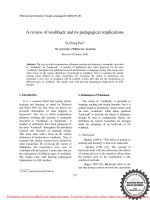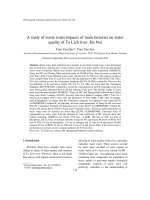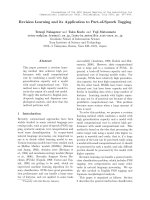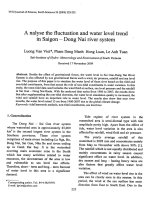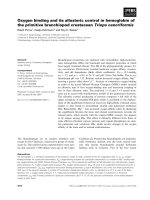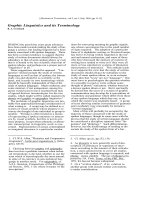Báo cáo " A review of washback and its pedagogical implications " potx
Bạn đang xem bản rút gọn của tài liệu. Xem và tải ngay bản đầy đủ của tài liệu tại đây (245.48 KB, 7 trang )
VNU Journal of Science, Foreign Languages 25 (2009) 257-263
257
A review of washback and its pedagogical implications
Yi-Ching Pan*
The university of Melbourne, Australia
Received 4 February 2009
Abstract. The way in which examinations influence teaching and learning is commonly described
as “washback” or “backwash”. A number of definitions have been proposed for the term
“washback” throughout the published research and literature on language testing. This study starts
with a focus on the various definitions of backwash or washback. Next, it examines the similar
concept terms defined by other researchers. By reviewing the variety of definitions, the
researcher’s own view of washback will be reached. Comes after that are the explorations of
different types of washback. The studies ends with drawing pedagogical implications for EFL
teachers.
1. Introduction
*
It is a common belief that testing affects
teaching and learning, as stated by Alderson
and Wall (1993 [1]) that “tests are held to be
powerful determiners of what happens in
classroom”. The way in which examinations
influence teaching and learning is commonly
described as “washback” or “backwash”. A
number of definitions have been proposed for
the term “washback” throughout the published
research and literature on language testing.
This study starts with a focus on the various
definitions of backwash or washback. Next, it
examines the similar concept terms defined by
other researchers. By reviewing the variety of
definitions, the researcher’s own view of
washback will be reached. Comes after that are
the explorations of different types of washback.
The studies ends with drawing pedagogical
implications for EFL teachers.
______
*
E-mail:
2. Definitions of Washback
The notion of “washback” is prevalent in
language teaching and testing literature, but it is
seldom found in dictionaries. Some writers used
the term “washback” while others preferred
“backwash” to describe the effects or influences
brought by tests or examinations. Below, the
definitions by various researchers are arranged
under the groupings of (a) backwash or (b)
washback.
2.1. Backwash
- Hughes (1989:1): “The effect of testing on
teaching and learning” is known as backwash.
- Spolsky (1994 [2]): The concept of
backwash deals with the unforeseen side-effects
of testing and not to the intended effects when
the primary goal of the examination is the
control of curricula.
- Biggs (1995 [3]): Backwash refers to the
fact that testing controls not only the curriculum
Evaluation notes were added to the output document. To get rid of these notes, please order your copy of ePrint 5.0 now.
Yi-Ching Pan / VNU Journal of Science, Foreign Languages 25 (2009) 257-263
258
but also teaching methods and students’
learning strategies.
2.2. Washback
- Alderson & Wall (1993 [1]): Washback
compels “teachers and learners to do things
they would not necessarily otherwise do
because of the test”.
- Messick (1996 [4]): Washback is
described as “the extent to which the
introduction and the use of a test influences
language and teachers to do things they would
not otherwise do that promote or inhibit
language learning”.
- Bailey (1996 [5]): Washback is the
“influence of testing on teaching and learning.”
- Shohamy, et al. (1996 [6]): Washback is
delineated as “the connections between testing
and learning”.
- Pearson (1998 [7]): “Public examinations
influence the attitudes, behaviours, and
motivation of teachers, learners, and parents,
and because examinations often come at the end
of a course, this influence is seen working in a
backward direction, hence the term, washback”.
- Cheng (2005 [8]): Washback indicates “an
intended or unintended (accidental) direction
and function of curriculum change on aspects of
teaching and learning by means of a change of
public examinations”.
3. Similar concept terms to washback
In addition to “backwash” and “washback”,
researchers used other similar terms stated
below to investigate the phenomena of the
influences or effects of tests on the educational
field.
a) Test impact (Andrews, 2004 [9];
McNamara, 2000 [10]; Wall, 1997 [11]; Bachman
& Palmer, 1996 [12])
Some researchers have argued that tests can
have more far-reaching effects in the
educational world than just in the language
classroom. Bachman & Palmer (1996 [12])
used the term “test impact” to refer to the
effects that tests have on individuals (teachers
and students) or educational systems and on the
society at large. Wall (Wall, 1997 [11]) held a
similar view by stating that “Test impact refers
to any of the effects that a test may have on
individuals, policies or practices within the
classroom, the school, the educational system,
and society as a whole”. McNamara (2004 [10])
claimed that “Tests can also have effects
beyond the classroom. The wider effect of tests
on the community as a whole, including the
school, is referred to as test impact”. Andrews
(2004 [9]) used “test impact” to describe “the
effects of tests on teaching and learning, the
educational system, and the various stake
holders in the education process”.
b) Systemic validity (Fredericksen &
Collins, 1989 [13])
Systemic validity refers to the effects of
instructional changes brought about by the
introduction the test into an educational system
as stated tests induce “in the education system
curricular and instructional changes that foster
cognitive skills that the test is designed to
measure”.
c) Consequential validity (Messick, 1989,
1996 [4,14])
Consequential validity encompasses
concepts ranging from the uses of tests, the
impacts of testing on test takers and teachers,
the examination of results by decision makers,
and the potential misuse, abuse, and unintended
usage of tests. In other words, consequential
validity implies that tests have various
influences both within and beyond the
classroom. In other words, consequential
validity refers to the societal implications of
testing that are only one facet of a broader,
unified concept of test validity.
Measurement-driver instruction (Shohamy
1992 [15])
Shohamy contended that “the use of
external tests as a device for creating impact on
Evaluation notes were added to the output document. To get rid of these notes, please order your copy of ePrint 5.0 now.
Yi-Ching Pan / VNU Journal of Science, Foreign Languages 25 (2009) 257-263
259
the educational process is often referred to as
the washback effect or measurement-driven
instruction”.
d) Curriculum-alignment (Shohamy et all
1996 [6])
Shohamy et al. defined curriculum-
alignment as “the curriculum is modified
according to test results”.
e) Washback validity: (Morrow 1986 [16])
“In essence, an examination of washback
validity would take testing researchers into the
classroom in order to observe the effect of their
tests in action.” In other words, washback
validity deals directly with the extent to which
the test meets the needs of students, educators,
researchers, administrators of tests, and anyone
who uses the test results in the future. In
addition, washback validity refers to the value
of the relationship between the test and any
associated teaching
4. Definition of washback in this study
After reviewing definitions of washback,
the term can be defined according to two major
perspectives: one at a narrower view within the
classroom at a micro level, and the other at a
wider and more holistic view beyond the
classroom at a macro level.
As suggested by Bachman & Palmer (1996
[12]), washback, at a macro level, refers to the
extent to which a test influences within the
society, ranging from government policy-
making, school administration, publishing, and
general opportunities, to parents’ expectations
of their children. At a micro level, washback
refers to the extent to which a test influences within
the classroom, mainly in the change or innovation
of curricula and teachers’ methodologies and the
influence of students’ learning. Bailey (1996 [5])
used the phrase “washback to the learners” to
indicate the effects of test on students, and
“washback to the programme” to indicate effects of
test on teachers, administrators, curriculum
developers, counselors, etc.
To summarize, the narrower definition of
washback focuses on the effects that a test has
on teaching and learning. The wider or more
holistic view of washback (also defined as test
impact) looks beyond the classroom to the
educational systems and society at large. All in
all, tests can have “significant impact not only
on individuals but also on practices and
policies—in the classroom, the school, the
educational system and in society as a whole”
(Wall 2005 [17]).
In this study, a broader interpretation if
washback will be adopted : washback at a macro
level beyond the classroom to investigate the test
washback in the school, the educational system
and society as a whole, and washback at a micro
level within the classroom to investigate the test
washback in the classroom, that is, the washback
effect of teaching and learning.
Types of Washback
Generally, washback can be analysed
according to two major types: positive and
negative, depending on whether it has a
beneficial or harmful impact on educational
practices (Hughes, 1989). This section explores
positive and negative washback in terms of both
the classroom setting and the
educational/political system.
5. Positive Washback
5.1. Classroom setting
Teachers and learners will be motivated to
fulfil their teaching and learning goals
(Anderson & Wall, 1993 [1]).
Good tests can be utilized and designed as
beneficial teaching-learning activities so as to
encourage a positive teaching-learning process
(Pearson, 1988:107).
A creative and innovative test can quite
advantageously result in a syllabus alteration or
a new syllabus (Davis, 1985 [18]).
Evaluation notes were added to the output document. To get rid of these notes, please order your copy of ePrint 5.0 now.
Yi-Ching Pan / VNU Journal of Science, Foreign Languages 25 (2009) 257-263
260
5.2. Educational/societal system
Decisional makers use the authority power
of high-stakes testing to achieve the goals of
teaching and learning, such as the introduction
of new textbooks and new curricula (Shohamy,
1992 [15]; Wall & Alderson 1993 [1]; Cheng;
2005 [8]).
Tests are encouraged to promote the idea of
lifelong learning and encourage people to learn
English (Language Testing and Training
Centre, 2008).
5.3. Negative Washback
Classroom setting
The test will lead to the narrowing of
content in the curriculum. What students have
learned is test language, instead of total phases
of understanding (Shohamy, 1992 [15]).
Teachers tend to ignore subjects and
activities that are not directly related to passing
the exam, and tests accordingly alter the
curriculum in a negative way (Vernon, 1956
[18]).
The tests may well fail to create a
correspondence between the learning principles
and/or the course objectives to which they
should be related (Cheng, 2005 [8]).
Many teachers detailed high anxiety, fear
and pressure to cover the material, as they felt
that their job performance was assessed by
students’ test scores (Shohamy, 1996 [6]).
Educators experienced negative reactions to
the stress brought about by public displays of
classroom scores. Inexperienced teachers felt a
greater degree of anxiety and pressure for
accountability than did teachers with more
experience (Fish, 1988 [19]).
“Testing programs substantially reduce the
time available for instruction, narrow curricular
offerings and modes of instruction, and
potentially reduce the capacities of teachers to
teach content and to use methods and materials
that are incompatible with standardized testing
formats” (Smith, 1991 [20]).
An increasing number of paid coaching
classes are set up to prepare students for exams,
but what students learn are test-taking skills
rather than language learning activities
(Wiseman, 1961 [21]).
Measurement-driven instruction will
definitely result in cramming, narrowing the
curriculum, focus of attention on those skills
that are most relevant to testing, placement of
constraints on teachers’ and students’ creativity
and spontaneity, and disparage the professional
judgment of educators (Madaus, 1988 [22]).
5.4. Educational/societal system
Decision makers overwhelmingly use tests
to promote their political agendas and to seize
influence and control of educational systems
(Shohamy, 1996 [6]). Tests are used as a
“lever” for change.
To present a clear view of positive and
negative washback at both micro-level
(classroom settings) and at macro-level
(educational and societal system), Tables 1 and
2 is presented below for classification.
Evaluation notes were added to the output document. To get rid of these notes, please order your copy of ePrint 5.0 now.
Yi-Ching Pan / VNU Journal of Science, Foreign Languages 25 (2009) 257-263
261
Table 1. Summary of Positive washback
Positive Washback
Classroom settings 1. Tests induce teachers to cover their subjects more thoroughly,
making them complete their syllabi within the prescribed time limits.
2. Tests motivate students to work harder to have a sense of
accomplishment and thus enhance learning.
3. Good tests can be utilized and designed as beneficial teaching-
learning activities so as to encourage positive teaching-learning
processes.
Educational/societal system
Decision makers use the authority power of high-stakes testing to achieve
the goals of teaching and learning, such as the introduction of new
textbooks and new curricula.
Table 2. Summary of Negative washback
Negative Washback
Classroom settings 1. Tests encourage teachers to narrow the curriculum and lose
instructional time, leading to “teaching to the test.”
2. Tests bring anxiety both to teachers and students and distort their
performance.
3. Students may not be able to learn real-life knowledge, but instead
learn discrete points of knowledge that are tested.
4. Cramming will lead students to have a negative positive toward tests
and accordingly alter their learning motivation.
Educational/societal system
Decision makers overwhelmingly use tests to promote their political
agendas and to seize influence and control of educational systems.
12323
To summarize, in terms of the classroom
setting at a micro level, the positive washback
integrates meaningful and innovative learning
activities in teachers’ educational
methodologies, and thus educators will devote
more attention to students’ intentions, interests,
and choices. Students at the same time will be
encouraged and motivated to work harder. On
the other hand, the negative washback is that
teachers will usually teach to the test, narrow
the curriculum and only focus on what will be
tested. Moreover, cramming will be the
washback brought by measurement-driven tests,
even though there is an ongoing debate as to
whether cramming is positive or negative
washback. In terms of educational setting, the
positive washback is that the authority can use
the test to attain its goal of teaching and
learning. However, the negative washback is
that the authority uses that goal to control and
obtain the power of the academic system that
will usually place undue pressure and anxiety
on school staffs, teachers and even students. In
other words, the washback on the side of the
educational setting is one coin with two sides,
depending on the stakeholder’s point of view.
6. Pedagogical Implications
By analyzing the possible positive and
negative washback that tests might bring about
at micro and macro levels, it seems that
teachers play an important role in fostering
different types of washback. In other words, the
beliefs of the teachers are a critical factor in
determining the washback effect. For example,
a test, on one hand, will encourage some
Evaluation notes were added to the output document. To get rid of these notes, please order your copy of ePrint 5.0 now.
Yi-Ching Pan / VNU Journal of Science, Foreign Languages 25 (2009) 257-263
262
teachers to think it’s important to plan their
curricula carefully to meet the needs of the test,
but on the other hand, other teachers may think
that tests force them to teach what they don’t
find suitable or appropriate for students. Spratt
(2005) has stated that the teacher plays a
significant role in determining the types and
intensity of washback, and thus, teachers have
become the sources of promoting positive
washback. Chapman and Snyder J. (2000:462)
have expressed a similar view by stating that
“its is not the examination itself that influences
teachers’ behavior, but teachers’ beliefs about
those changes”. As Watanbee (2005) suggested,
teachers should be provided with in-service
training and be familiar with a wide range of
teaching methods.
Tests sometimes are used by schools or
school administrations as a “lever” to introduce
the innovation of new curricula, but it may
change the format of what teachers instruct, not
foster an in-depth change of teaching
methodologies as a whole. As Wall (2005:283)
stated, “examinations cannot influence teachers
to change their practices if they are not
committed to the new ideas and if they do not
have the skills that will enable them to
experiment with, evaluate and make appropriate
adjustments to new methods”. In other words,
teachers themselves must conduct the changes
and teachers need to have the necessary skills to
adapt the changes. Again, teachers play a very
crucial role in promoting positive washback or
hindering negative washback.
To conclude, there are two major
perspectives that teachers should bear in mind.
If we are the ones who make the tests, we
should try to make a match between what is
tested and what is taught by using more direct
testing, making sure the test is known by
students. Tests are one factor that will lead the
teacher to “teach to the test”, and what students
learn might be discrete points of language, not
the communicative part of language they need
in real life. To remedy this, it is desirable to use
authentic and direct tests (Bailey, 1996). If we
are responsible for helping students pass the
test, we should try our best to learn more
teaching methodologies by taking more training
courses, engaging in peer observations and
utilizing the tests to enhance students’ learning
while at the same time not inhibiting students’
motivation by cramming too much. As teachers,
“we may have limited power to influence high-
stakes national and international examinations,
but we do have tremendous power to lead
students to learn, to teach them language and
how to work with tests and test results.”
(Bailey, 2005) All in all, it’s the teacher who
has the most power to turn it into positive or
negative washback.
References
[1] C. Alderson, D. Wall, Does washback exist? Applied
Linguistics, 14 (1993) 115.
[2] B. Spolsky, The examination of classroom backwash
cycle: Some historical cases, in Nunan, D, Berry, V
and Berry, R. (Eds) Bringing about change in language
education, University of Hong Kong, Dept. of
Curriculum Studies, Hong Kong, 1994.
[3] J.B. Biggs, Assumptions underlying new approaches to
assessment, Curriculum Forum, 4 (1995) 1.
[4] S. Messick, Validity and washback in language testing.
Language Testing 13 (1996) 241.
[5] K.M. Bailey, Working for washback: A review of the
washback concept in language testing, Language
Testing, 13 (1996) 257.
[6] E. Shohamy, S. Donitsa-Schmidt, L. Ferman, Test
impact revisited: Washback effect over time, Language
Testing 13 (1996b) 298.
[7] L. Pearson, Tests as levers of change (or “putting first
things first”). In D. Chamberlain & R. Baumgartner
(Eds.), ESP in the classroom: Practice and evaluation
ELT Documents #128, (pp. 98-107), Modern English
Publication in association with the British Council,
London, 1988.
[8] L. Cheng, Changing Language Teaching Through
Language Testing: A Washback Study, Cambridge
University Press, Cambridge, 2005.
[9] S. Andrews, Washback and Innovation, In L. Cheng,
Y. Watanabe & A. Curtis (Eds.), Washback in
Language testing (pp. 37-50), Mahwah, New Jersey:
Lawrence Erlbaum Associates, Publishers, 2004.
[10] T. McNamara, Language Testing, Oxford University
Press, Oxford, 2000.
Evaluation notes were added to the output document. To get rid of these notes, please order your copy of ePrint 5.0 now.
Yi-Ching Pan / VNU Journal of Science, Foreign Languages 25 (2009) 257-263
263
[11] D. Wall, Impact and washback in language testing, In
C. C. & D. Corson (Eds.), Encyclopaedia of language
and education, Language Testing and Assessment 7
(1997) 291.
[12] F. Bachman, S. Palmer, Language testing in Practice,
Oxford University Press, Oxford, 1996.
[13] R. Fredericksen, A. Collins, A system approach to
educational testing Educational Researcher 18 (1989) 27.
[14] S. Messick, Validity. In R. Linn (Ed.), Educational
Mesurement (pp. 13-103), Macmillian, New York,
1989.
[15] E. Shohamy, Beyond proficiency testing: A diagnostic
feedback testing model for assessing foreign language
learning, The Modern Language Journal, 76 (1992) 513.
[16] K. Morrow, The evaluation of tests of communicative
performance, In E. Portal (Ed.), Innovations in
Language Testing: Proceedings of the IUS/NFER
Conference (pp. 1-13), NFER/Nelson, London, 1986.
[17] D. Wall, The impact of high-stakes examinations on
classroom teaching, Cambridge University Press,
Cambridge, 2005.
[18] P.E. Vernon, The measurement of abilities, University
of London Press, London, 1996.
[19] J. Fish, Responses to mandated standardised testing.
Unpublished doctoral dissertation, University of
California, Los Angeles, 1988.
[20] M.L. Smith, Put to the test: The effects of external testing
on teachers, Educational Researchers 20 (1991) 8.
[21] S. Wiseman, Examinations and English education,
Manchester University Press, England, 1961.
[22] G.F. Madaus, The influence of testing on the
curriculum. In L. N. Tanner (Ed.), Critical issues in
curriculum: Eighty-seventh yearbook of the National
Society for the study of education (pp. 83-121),
University of Chicago Press, Chicago, 1988.
Điểm tư liệu về khái niệm "kênh hồi đáp"
và những gợi ý sư phạm
Phan Di Tịnh
Đại học Melbourne, Australia
Phương thức mà các kỳ thi ảnh hưởng tới việc dạy và học thường được miêu tả như là “kênh phản
hồi”. Đã có nhiều định nghĩa về “kênh phản hồi” được đề xuất trong các nghiên cứu và tư liệu bàn về
kiểm tra - đánh giá ngôn ngữ. Bài viết này bắt đầu bằng việc nhấn mạnh vào nhiều định nghĩa khác
nhau về “kênh phản hồi”. Tiếp theo, chúng tôi khảo sát một số thuật ngữ có cùng khái niệm tương tự
trong một số nghiên cứu khác. Với việc điểm lại một số định nghĩa khác nhau, tác già bài viết đưa ra
quan điểm riêng của mình về vấn đề này. Tiếp theo là những khám phá về các loại hình “kênh phản
hồi”. Kết thúc bài viết là những đề xuất mang tính sư phạm dành cho các giáo viên dạy tiếng Anh như
một ngoại ngữ.
Evaluation notes were added to the output document. To get rid of these notes, please order your copy of ePrint 5.0 now.

